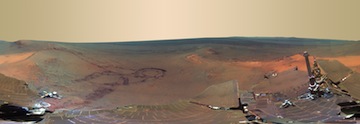 The conquest of space may one day become man’s salvation. Mars is our species most likely second home. This picture, taken over a period of several months, is the most detailed ever seen of the surface of the red planet. The view is presented in false color to make some differences between materials easier to see. Download the high-res version here.
The conquest of space may one day become man’s salvation. Mars is our species most likely second home. This picture, taken over a period of several months, is the most detailed ever seen of the surface of the red planet. The view is presented in false color to make some differences between materials easier to see. Download the high-res version here.
From fresh rover tracks to an impact crater blasted billions of years ago, the scene, recorded from the Opportunity’s mast-mounted color camera includes the rover’s own solar arrays and deck in the foreground, gives a sense of sitting on the rover and taking in the view.
North is at the center of the image. South is at both ends. On the far left at the horizon is ‘Rich Morris Hill.’ That outcrop on Cape York was informally named in memory of John R. ‘Rich’ Morris (1973-2011), an aerospace engineer and musician who was a Mars rover team member and mission manager at NASA’s Jet Propulsion Laboratory, Pasadena.
During the recent four months that Opportunity worked on Mars, activities included radio-science observations to better understand Martian spin axis dynamics and thus interior structure, investigations of the composition and textures of an outcrop exposing an impact-jumbled rock formation on the crater rim, monitoring the atmosphere and surface for changes, and acquisition of this full-color mosaic of the surroundings.
The panorama combines exposures taken through Pancam filters centered on wavelengths of 753 nanometers (near infrared), 535 nanometers (green) and 432 nanometers (violet).